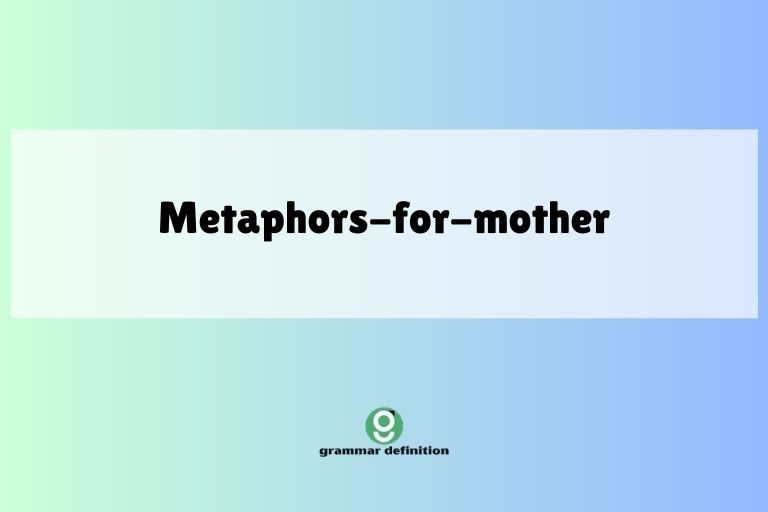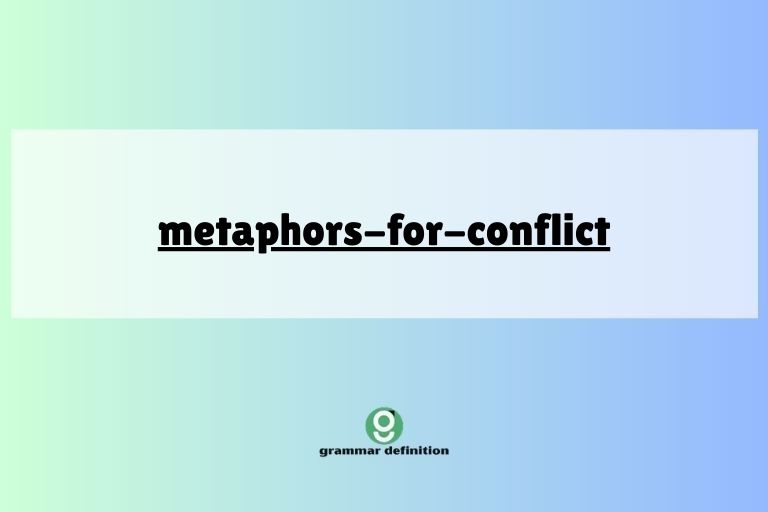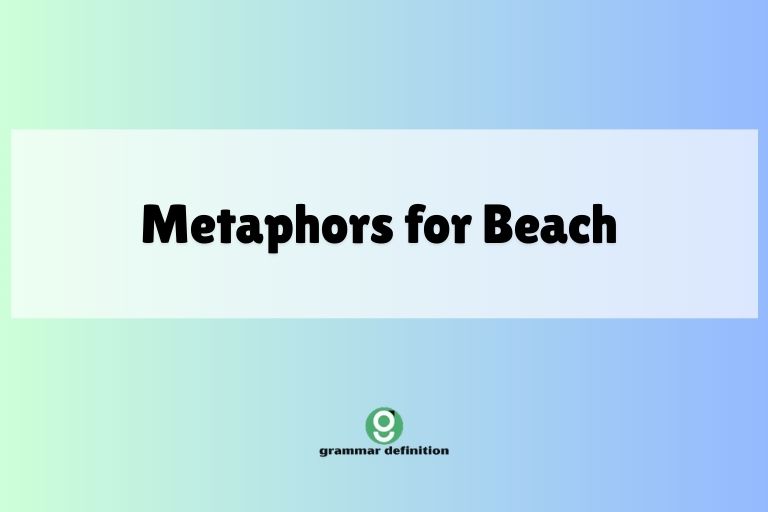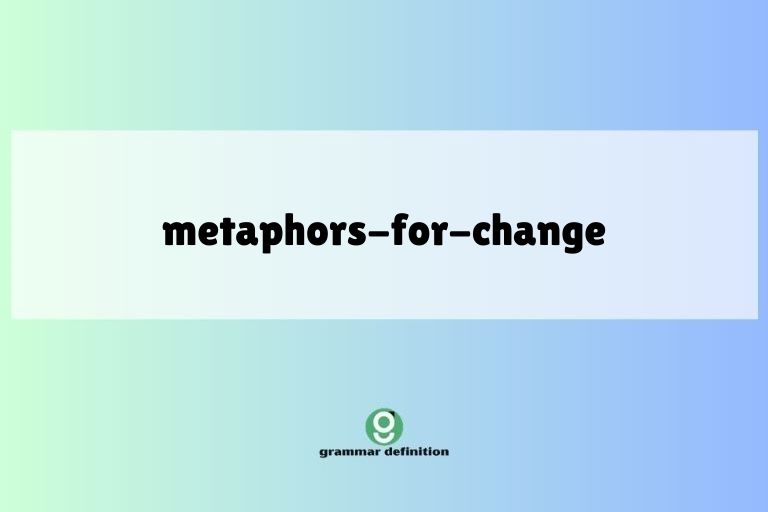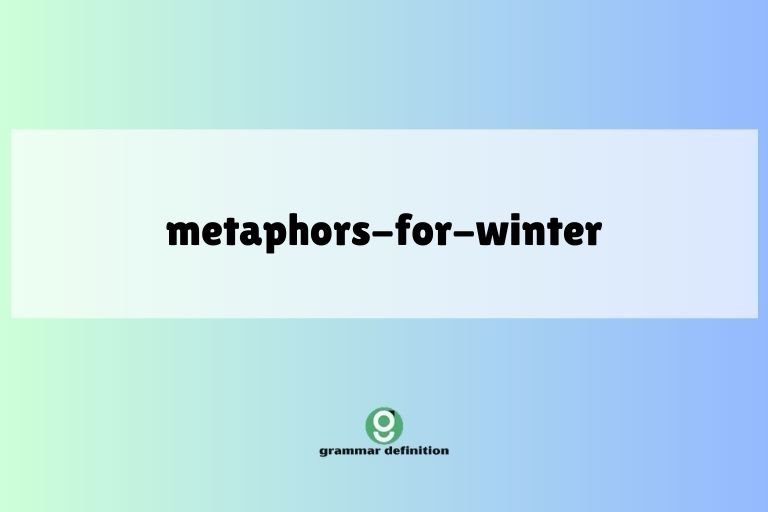Anxiety Metaphors: Understanding and Using Figurative Language
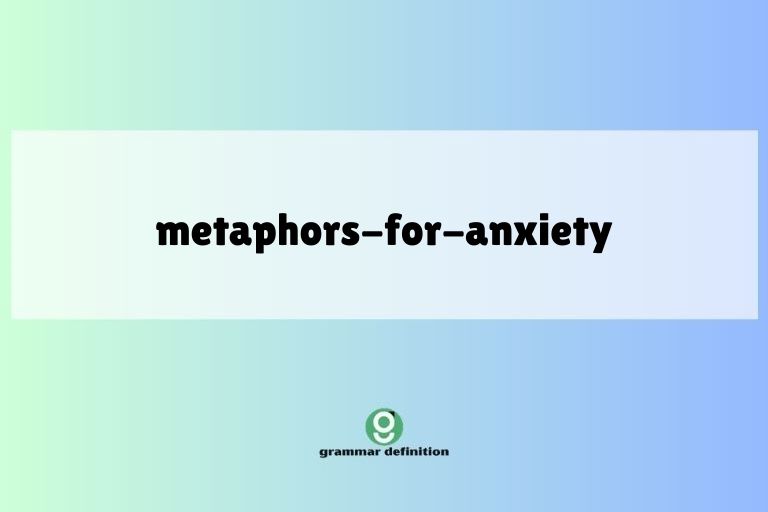
Anxiety is a complex emotion, often difficult to articulate directly. Metaphors provide a powerful tool for expressing the often-intangible feelings associated with anxiety.
By understanding these metaphors, we can better grasp the experience of anxiety, improve communication about mental health, and enhance our writing and speaking. This article explores the various metaphors used to describe anxiety, how they function, and how to use them effectively.
This article will benefit anyone seeking to understand anxiety better, including those who experience it themselves, mental health professionals, writers, and English language learners looking to expand their vocabulary and figurative language skills.
Table of Contents
- Introduction
- Definition of Metaphor for Anxiety
- Structural Breakdown of Anxiety Metaphors
- Types of Metaphors for Anxiety
- Examples of Anxiety Metaphors
- Usage Rules for Anxiety Metaphors
- Common Mistakes When Using Anxiety Metaphors
- Practice Exercises
- Advanced Topics
- FAQ
- Conclusion
Definition of Metaphor for Anxiety
A metaphor is a figure of speech that directly compares two unrelated things, suggesting a likeness or analogy between them. In the context of anxiety, metaphors are used to describe the abstract and often overwhelming feelings associated with anxiety by relating them to more concrete and understandable concepts.
These metaphors allow us to grasp the emotional and physical sensations of anxiety in a more tangible way.
Metaphors for anxiety serve several critical functions. They provide a descriptive tool for those struggling to articulate their experiences. They offer a communication bridge between individuals who may not share the same experiences, fostering empathy and understanding. Finally, they can act as a cognitive aid, helping individuals to process and manage their anxiety by framing it in a relatable context.
The context in which a metaphor is used significantly impacts its effectiveness. A metaphor that resonates with one person may not resonate with another.
Therefore, it’s crucial to consider the audience, the specific type of anxiety being described, and the overall tone of the communication when selecting and using metaphors for anxiety.
Structural Breakdown of Anxiety Metaphors
Anxiety metaphors typically consist of two main elements: the tenor and the vehicle. The tenor is the subject being described (in this case, anxiety). The vehicle is the object or concept to which anxiety is being compared. The effectiveness of a metaphor depends on the relationship established between the tenor and the vehicle.
For example, in the metaphor “Anxiety is a storm,” the tenor is “anxiety,” and the vehicle is “a storm.” The metaphor works because it draws parallels between the overwhelming, unpredictable, and destructive nature of a storm and the similar feelings associated with anxiety. The link between the tenor and vehicle should be clear and evocative to create a powerful and resonant image.
The structure can be further analyzed by considering the ground of the metaphor. The ground refers to the shared characteristics or qualities between the tenor and the vehicle. In the “Anxiety is a storm” example, the ground includes qualities such as intensity, unpredictability, and a sense of being overwhelmed. Identifying the ground helps to clarify the intended meaning and strengthen the impact of the metaphor.
Types of Metaphors for Anxiety
There are many different ways to conceptualize anxiety through metaphors. Each type captures a different aspect of the experience, providing a varied toolkit for expressing and understanding this complex emotion.
Anxiety as Weather
This is one of the most common types of anxiety metaphors. It draws parallels between the fluctuating and often unpredictable nature of weather and the emotional ups and downs of anxiety.
Weather metaphors can convey the intensity, duration, and pervasiveness of anxiety.
Anxiety as Weight or Burden
These metaphors emphasize the feeling of being weighed down or burdened by anxiety. They highlight the sense of heaviness, restriction, and difficulty in moving forward that anxiety can create.
Weight metaphors can also suggest the cumulative effect of anxiety over time.
Anxiety as an Animal
Comparing anxiety to an animal can capture its primal, instinctual nature. Depending on the animal chosen, these metaphors can convey feelings of fear, restlessness, being trapped, or being hunted.
Animal metaphors often highlight the physical sensations of anxiety, such as a racing heart or shortness of breath.
Anxiety as a Physical Force
These metaphors portray anxiety as a force that pushes, pulls, or constricts. They emphasize the feeling of being overwhelmed or controlled by anxiety, as if it were an external power acting upon the individual.
Physical force metaphors can also convey the sense of being trapped or unable to escape anxiety’s grip.
Anxiety as a Journey
These metaphors frame anxiety as a difficult or challenging journey. They can highlight the sense of being lost, disoriented, or uncertain about the future.
Journey metaphors often emphasize the long-term nature of anxiety management and the need for resilience and perseverance.
Anxiety as a Battle
These metaphors portray anxiety as an enemy or opponent to be fought. They can highlight the sense of struggle, conflict, and exhaustion that anxiety can create.
Battle metaphors often emphasize the need for strength, courage, and strategic thinking in managing anxiety.
Anxiety as a Voice
These metaphors represent anxiety as an internal voice that whispers doubts, fears, and criticisms. They can highlight the intrusive and persistent nature of anxious thoughts.
Voice metaphors often emphasize the need to challenge and silence the negative self-talk associated with anxiety.
Anxiety as an Object
These metaphors use tangible objects to symbolize anxiety. The specific object chosen can convey different aspects of the experience, such as fragility, confinement, or threat.
Object metaphors can be particularly effective in making abstract feelings more concrete and understandable.
Examples of Anxiety Metaphors
The following tables provide examples of anxiety metaphors categorized by type. Each example illustrates how a specific vehicle can be used to convey the feeling of anxiety.
The table below shows examples of how anxiety can be compared to different types of weather. These metaphors highlight the unpredictable and sometimes overwhelming nature of anxiety.
| Metaphor | Explanation |
|---|---|
| Anxiety is a thunderstorm raging inside me. | Conveys the intensity and overwhelming nature of a panic attack. |
| My anxiety is a dark cloud hanging over my head. | Represents a persistent feeling of dread and unease. |
| Anxiety feels like a relentless downpour. | Emphasizes the constant and unrelenting nature of anxious thoughts. |
| My mind is a hurricane of worries. | Illustrates the chaotic and destructive nature of anxious thoughts. |
| Anxiety is the fog that obscures my vision. | Represents the feeling of being confused and disoriented by anxiety. |
| The anxiety is a blizzard, isolating me from the world. | Highlights the feeling of isolation and being overwhelmed. |
| My heart races like a tornado approaching. | Connects the physical symptoms of anxiety with a powerful weather event. |
| Anxiety is the heatwave that leaves me drained. | Emphasizes the exhausting effect of constant worry. |
| The anxiety is a drizzle that never stops. | Illustrates the persistent, low-level feeling of unease. |
| My thoughts are scattered like leaves in a gust of wind. | Represents the feeling of being unable to focus or concentrate. |
| Anxiety is like a sudden frost, freezing me in place. | Conveys the feeling of being paralyzed by fear. |
| The anxiety is a thick smog, clouding my judgment. | Represents the feeling of being unable to think clearly. |
| My stomach churns like the sea during a storm. | Connects the physical symptoms of anxiety with a powerful natural event. |
| Anxiety is the drought that withers my spirit. | Emphasizes the draining and debilitating effect of anxiety. |
| The anxiety is a cold snap that chills me to the bone. | Illustrates the feeling of being emotionally and physically cold. |
| My breath catches in my chest like before a storm. | Connects the physical symptoms of anxiety with a sense of impending doom. |
| Anxiety is the hail that batters me relentlessly. | Emphasizes the painful and overwhelming nature of anxiety. |
| The anxiety is a tidal wave, threatening to engulf me. | Represents the feeling of being completely overwhelmed. |
| My mind is a swirling vortex of negative thoughts. | Illustrates the chaotic and destructive nature of anxious thinking. |
| Anxiety is the oppressive humidity that makes it hard to breathe. | Emphasizes the feeling of being suffocated or restricted. |
| The anxiety is a dust storm, blinding me to the good. | Represents the feeling of being unable to see the positive aspects of life. |
| My muscles tense like the earth before an earthquake. | Connects the physical symptoms of anxiety with a sense of impending disaster. |
| Anxiety is the ice storm that makes everything treacherous. | Emphasizes the feeling of danger and uncertainty. |
The following table shows examples of metaphors that use weight or burden to describe anxiety. These highlight the feeling of being weighed down and restricted by anxiety.
| Metaphor | Explanation |
|---|---|
| Anxiety is a heavy weight on my chest. | Conveys the physical sensation of pressure and constriction. |
| My anxiety is a backpack full of stones. | Represents the cumulative burden of worries and fears. |
| Anxiety feels like carrying the world on my shoulders. | Emphasizes the feeling of responsibility and pressure. |
| My thoughts are anchored by the weight of anxiety. | Illustrates the feeling of being stuck and unable to move forward. |
| Anxiety is a chain that binds me to my fears. | Represents the feeling of being trapped and restricted. |
| The anxiety is a lead blanket smothering me. | Highlights the feeling of being suffocated and overwhelmed. |
| My heart feels heavy with the weight of worry. | Connects the physical symptoms of anxiety with emotional burden. |
| Anxiety is the anchor that keeps me from soaring. | Emphasizes the feeling of being held back and unable to reach potential. |
| The anxiety is a millstone around my neck. | Illustrates the feeling of being burdened and restricted. |
| My mind is weighed down by a ton of what-ifs. | Represents the overwhelming nature of anxious thoughts. |
| Anxiety is like a concrete block tied to my ankles. | Conveys the feeling of being unable to move freely. |
| The anxiety is a suit of armor, protecting me but also isolating me. | Represents the feeling of being both protected and restricted. |
| My breath is shallow, as if something is sitting on my chest. | Connects the physical symptoms of anxiety with a sense of pressure. |
| Anxiety is the ball and chain that keeps me from happiness. | Emphasizes the feeling of being trapped and unable to find joy. |
| The anxiety is a yoke I can’t seem to shake off. | Illustrates the feeling of being burdened and controlled. |
| My shoulders slump under the weight of expectation. | Connects the physical posture with the emotional burden of anxiety. |
| Anxiety is the albatross I can’t shake. | Emphasizes the feeling of being haunted and burdened by anxiety. |
| The anxiety is a heavy cloak, disguising my true self. | Represents the feeling of being hidden and restricted. |
| My spirit is crushed under the weight of my fears. | Illustrates the debilitating effect of anxiety on one’s well-being. |
| Anxiety is the quicksand that sucks me down. | Emphasizes the feeling of being trapped and sinking. |
| The anxiety is a vise that constricts my heart. | Represents the physical sensation of tightness and pressure. |
| My energy is drained by the weight of my worries. | Connects the feeling of fatigue with the burden of anxiety. |
| Anxiety is the shackle that binds me to my past. | Emphasizes the feeling of being unable to move on from past traumas. |
The table below contains examples of metaphors that compare anxiety to animals, capturing the primal and instinctual nature of the emotion.
| Metaphor | Explanation |
|---|---|
| Anxiety is a caged tiger pacing in my chest. | Conveys the feeling of restlessness and pent-up energy. |
| My anxiety is a swarm of bees buzzing in my head. | Represents the chaotic and overwhelming nature of anxious thoughts. |
| Anxiety feels like a snake coiling in my stomach. | Emphasizes the physical sensation of unease and dread. |
| My mind is a mouse trapped in a maze of worries. | Illustrates the feeling of being lost and unable to escape. |
| Anxiety is a hawk circling, waiting to attack. | Represents the feeling of constant vigilance and impending threat. |
| The anxiety is a spider spinning a web of fear. | Highlights the feeling of being trapped and ensnared. |
| My heart races like a hummingbird’s wings. | Connects the physical symptoms of anxiety with rapid movement. |
| Anxiety is the wolf at the door, always threatening. | Emphasizes the feeling of constant danger and vulnerability. |
| The anxiety is a shadow lurking like a predator. | Illustrates the feeling of being watched and threatened. |
| My thoughts flutter like trapped birds. | Represents the feeling of being unable to control thoughts. |
| Anxiety is like a venomous snake, poisoning my peace. | Conveys the destructive and harmful nature of anxiety. |
| The anxiety is a shadow that follows me like a loyal dog. | Represents the constant and inescapable presence of anxiety. |
| My breath is shallow, like a fish out of water. | Connects the physical symptoms of anxiety with a sense of distress. |
| Anxiety is the leech that sucks my energy. | Emphasizes the draining and debilitating effect of anxiety. |
| The anxiety is a parrot, repeating negative thoughts. | Illustrates the repetitive and intrusive nature of anxious thoughts. |
| My skin crawls like ants marching across it. | Connects the physical sensations of anxiety with a feeling of unease. |
| Anxiety is the lion roaring in my head. | Emphasizes the overwhelming and frightening nature of anxiety. |
| The anxiety is a chameleon, changing its form to trick me. | Represents the unpredictable and deceptive nature of anxiety. |
| My spirit shrinks like a snail retreating into its shell. | Illustrates the feeling of withdrawal and isolation. |
| Anxiety is the bear trap that snaps shut on my joy. | Emphasizes the feeling of being suddenly caught and trapped. |
| The anxiety is a swarm of locusts, devouring my peace. | Represents the destructive and overwhelming nature of anxiety. |
| My senses are heightened like a deer sensing danger. | Connects the physical awareness with a feeling of threat. |
| Anxiety is the owl hooting in the darkness of my mind. | Emphasizes the feeling of foreboding and uncertainty. |
Usage Rules for Anxiety Metaphors
Using metaphors effectively requires careful consideration of several factors. First, ensure the metaphor is relevant to the specific aspect of anxiety you are trying to describe. A metaphor about physical tension might be more appropriate for describing a panic attack than a metaphor about cognitive distortions.
Second, ensure the metaphor is clear and understandable to your audience. Avoid obscure or overly complex metaphors that might confuse rather than clarify. The connection between the tenor and the vehicle should be readily apparent.
Third, be consistent with your metaphor. Avoid mixing metaphors in a way that creates a confusing or contradictory image. If you start by comparing anxiety to a storm, stick with weather-related imagery throughout the description.
Finally, be sensitive to the potential impact of your metaphor. Metaphors can be powerful tools, but they can also be triggering or insensitive if used carelessly. Consider the audience’s background and experiences when selecting and using metaphors for anxiety.
Common Mistakes When Using Anxiety Metaphors
One common mistake is using clichéd metaphors that have lost their impact through overuse. Phrases like “anxiety is a monster” or “anxiety is a weight” can feel generic and unoriginal. Strive for fresh and evocative metaphors that capture the unique nuances of the experience.
Another mistake is using metaphors that are inaccurate or misleading. A metaphor that trivializes or downplays the severity of anxiety can be harmful. Ensure your metaphors reflect the genuine challenges and suffering associated with anxiety.
Mixing metaphors is another frequent error. For example, saying “Anxiety is a storm that’s also a weight on my shoulders” creates a confusing image.
Maintain consistency within your metaphorical language.
The table below shows examples of common mistakes when using metaphors for anxiety, along with corrections.
| Incorrect Metaphor | Corrected Metaphor | Explanation |
|---|---|---|
| Anxiety is a monster. | Anxiety is a shadow that follows me everywhere. | Replaces a clichéd metaphor with a more evocative and specific image. |
| Anxiety is just a little hiccup. | Anxiety is a relentless wave crashing over me. | Replaces a trivializing metaphor with one that reflects the severity of anxiety. |
| Anxiety is a storm that’s also a ball and chain. | Anxiety is a storm raging inside me. | Avoids mixing metaphors by sticking to a single image. |
| My anxiety is a beautiful butterfly. | My anxiety is a swarm of angry bees. | Ensures the metaphor accurately reflects the unpleasant and distressing nature of anxiety. |
| Anxiety is a walk in the park. | Anxiety is like navigating a minefield. | The corrected metaphor better captures the dangers and challenges associated with anxiety. |
| Anxiety is a test. | Anxiety is a relentless interrogation. | The corrected metaphor conveys a sense of pressure and scrutiny. |
| Anxiety is sunshine. | Anxiety is a burning ember. | The corrected metaphor better reflects the discomfort and intensity of anxiety. |
| Anxiety is a flower. | Anxiety is a thorny vine. | The corrected metaphor conveys a sense of being trapped or entangled. |
| Anxiety is a game. | Anxiety is a high-stakes gamble. | The corrected metaphor emphasizes the uncertainty and potential consequences of anxiety. |
Practice Exercises
These exercises will help you practice identifying and using metaphors for anxiety.
Exercise 1: Identifying Metaphors
Identify the metaphor in each sentence and explain what aspect of anxiety it conveys.
| Question | Answer |
|---|---|
| 1. My anxiety is a tight knot in my stomach. | Metaphor: “tight knot.” Conveys the physical tension and discomfort associated with anxiety. |
| 2. Anxiety is the thief that steals my joy. | Metaphor: “thief.” Conveys the feeling of being robbed of happiness and peace. |
| 3. My mind is a runaway train of worries. | Metaphor: “runaway train.” Conveys the feeling of being out of control and overwhelmed. |
| 4. Anxiety is a maze with no exit. | Metaphor: “maze.” Conveys the feeling of being lost and trapped. |
| 5. My anxiety is a constant static in my mind. | Metaphor: “constant static.” Conveys the persistent and irritating nature of anxious thoughts. |
| 6. Anxiety is a puppet master pulling my strings. | Metaphor: “puppet master.” Conveys the feeling of being controlled and manipulated by anxiety. |
| 7. My anxiety is a wall that separates me from others. | Metaphor: “wall.” Conveys the feeling of isolation and disconnection. |
| 8. Anxiety is a fire burning through my energy. | Metaphor: “fire.” Conveys the feeling of being drained and exhausted. |
| 9. My anxiety is a shadow that darkens my every thought. | Metaphor: “shadow.” Conveys the feeling of negativity and dread. |
| 10. Anxiety is a cage that confines my spirit. | Metaphor: “cage.” Conveys the feeling of being trapped and restricted. |
Exercise 2: Creating Metaphors
Create a metaphor for anxiety using the following vehicles:
| Vehicle | Example Metaphor |
|---|---|
| 1. A pressure cooker | Anxiety is a pressure cooker, building up until it explodes. |
| 2. A broken record | Anxiety is like a broken record, repeating the same worries over and over. |
| 3. A tangled web | Anxiety is a tangled web of thoughts that I can’t untangle. |
| 4. A storm at sea | Anxiety is a storm at sea, tossing me around with no control. |
| 5. A tightrope walk | Anxiety is like walking a tightrope, always afraid of falling. |
| 6. A computer virus | Anxiety is a computer virus, corrupting my thoughts and actions. |
| 7. A ticking bomb | Anxiety is a ticking bomb, waiting to explode with panic. |
| 8. A dark forest | Anxiety is a dark forest, full of shadows and hidden dangers. |
| 9. A heavy fog | Anxiety is a heavy fog, clouding my mind and making it hard to see. |
| 10. A locked room | Anxiety is a locked room, trapping me with my fears. |
Exercise 3: Rewriting Sentences with Metaphors
Rewrite the following sentences using a metaphor to describe anxiety:
| Original Sentence | Rewritten Sentence with Metaphor |
|---|---|
| 1. I feel very worried about the upcoming presentation. | The upcoming presentation feels like a looming cliff I have to jump off. |
| 2. My thoughts are racing and I can’t focus. | My thoughts are a wild river, impossible to navigate. |
| 3. I am constantly afraid of something bad happening. | Fear is a constant shadow, lurking just behind me. |
| 4. I feel overwhelmed by my responsibilities. | My responsibilities are a mountain I can’t climb. |
| 5. I can’t relax because I’m always on edge. | I am a tightly wound spring, ready to snap. |
| 6. The pressure is making me feel stressed. | The pressure is a vise squeezing the life out of me. |
| 7. I feel trapped by my anxious thoughts. | My anxious thoughts are a prison, holding me captive. |
| 8. The uncertainty is making me feel uneasy. | Uncertainty is a shaky bridge I must cross. |
| 9. My heart races when I think about the future. | The future is a roller coaster, sending my heart into a frenzy. |
| 10. I feel like I’m losing control. | I’m a kite, cut loose and drifting in the wind. |
Advanced Topics
For advanced learners, exploring the cultural and historical context of anxiety metaphors can provide deeper insights. Different cultures may use different metaphors to describe anxiety based on their unique values and experiences.
For example, some cultures may emphasize the social aspects of anxiety, while others may focus on the individual’s internal experience.
Analyzing the use of anxiety metaphors in literature and art can also be a rewarding exercise. Examining how authors and artists use figurative language to portray anxiety can reveal nuanced and powerful expressions of this complex emotion.
Finally, consider exploring the connection between metaphors and cognitive behavioral therapy (CBT). CBT often uses metaphors to help individuals reframe their anxious thoughts and behaviors.
Understanding the underlying metaphors can enhance the effectiveness of CBT techniques.
FAQ
Here are some frequently asked questions about metaphors for anxiety:
Q1: Why are metaphors useful for describing anxiety?
A1: Metaphors are useful because they allow us to express abstract and often difficult-to-articulate feelings in a more concrete and understandable way. Anxiety is a complex emotion with a wide range of physical and emotional symptoms.
Metaphors provide a way to capture the essence of these experiences by relating them to familiar concepts.
Q2: Can metaphors help me manage my anxiety?
A2: Yes, metaphors can be a helpful tool in managing anxiety. By framing anxiety in a relatable context, metaphors can help you to understand and process your feelings more effectively.
They can also provide a sense of distance and perspective, allowing you to challenge and reframe your anxious thoughts.
Q3: How do I choose the right metaphor for my anxiety?
A3: The “right” metaphor is one that resonates with you personally and accurately reflects your experience of anxiety. Consider the specific symptoms and feelings you are trying to describe, and choose a metaphor that captures those aspects.
Experiment with different metaphors until you find one that feels meaningful and helpful.
Q4: Are some metaphors for anxiety better than others?
A4: Some metaphors may be more effective than others depending on the individual and the context. Avoid metaphors that are clichéd, trivializing, or inaccurate.
Look for metaphors that are fresh, evocative, and reflect the genuine challenges of anxiety. A good metaphor should resonate with you and help you understand your experience better.
Q5: Can using metaphors worsen my anxiety?
A5: While generally helpful, metaphors could potentially worsen anxiety if they are overly negative or triggering. Choose metaphors carefully and be mindful of their potential impact on your emotional state.
If a particular metaphor makes you feel worse, try a different one.
Q6: How can I use metaphors in therapy?
A6: Metaphors can be a valuable tool in therapy for expressing your feelings, understanding your patterns of thinking, and developing coping strategies. Share your metaphors with your therapist and discuss how they relate to your experience of anxiety.
Your therapist can also help you to explore and reframe your metaphors to promote positive change.
Q7: Where can I find more examples of anxiety metaphors?
A7: You can find more examples of anxiety metaphors in literature, poetry, and personal essays. Online forums and support groups for people with anxiety can also be a valuable source of metaphors.
You can also create your own metaphors by reflecting on your personal experience of anxiety and identifying concepts that capture its essence.
Q8: Are there cultural differences in how anxiety is described metaphorically?
A8: Yes, there can be significant cultural differences in how anxiety is described metaphorically. Different cultures may emphasize different aspects of the experience based on their values, beliefs, and social norms.
For example, some cultures may focus on the social consequences of anxiety, while others may emphasize the individual’s internal experience. Being aware of these cultural differences can help you to understand and communicate about anxiety more effectively.
Conclusion
Metaphors are powerful tools for understanding and expressing the complex experience of anxiety. By using figurative language, we can make abstract feelings more concrete, improve communication, and gain new insights into our own emotional states.
Understanding the different types of anxiety metaphors, their structure, and usage rules can significantly enhance your ability to articulate and manage anxiety.
Remember to choose metaphors that are relevant, clear, consistent, and sensitive to your audience. Avoid clichéd or inaccurate metaphors, and be mindful of the potential impact of your language.
With practice and careful consideration, you can harness the power of metaphors to better understand and communicate about anxiety.
Continue to explore and experiment with different metaphors to find those that resonate with you personally. By developing your metaphorical vocabulary, you can gain a deeper understanding of anxiety and improve your ability to cope with its challenges.


